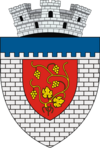Târgu Neamt
| Târgu Neamț | ||
|---|---|---|
| Town | ||
|
||
 Location of Târgu Neamț |
||
| Coordinates: 47°12′9″N 26°21′31″E / 47.20250°N 26.35861°ECoordinates: 47°12′9″N 26°21′31″E / 47.20250°N 26.35861°E | ||
| Country |
|
|
| County | Neamț County | |
| Status | Town | |
| Government | ||
| • Mayor | Vasile Harpa (Social Liberal Union) | |
| Population (2011) | ||
| • Total | 18,695 | |
| Time zone | EET (UTC+2) | |
| • Summer (DST) | EEST (UTC+3) | |
| Website | http://www.primariatgneamt.ro/ | |
Târgu Neamț (Romanian pronunciation: [ˌtɨrɡu ˈne̯amt͡s]; German: Niamtz, Hungarian: Németvásár, Hebrew: נאמץ טרגו, Latin: Ante Castrum Nempch) is a town in Neamț County, Romania, on the Neamț River. It had, as of 2002[update], a population of 20,496. Three villages are administered by the town: Blebea, Humulești and Humuleștii Noi.
Originally a market town, hence its name (in Romanian "târg" = market), it had an important role in Moldavian culture. It was first mentioned in a late-14th century document.
The name is derived from the Slavic word nemeti meaning "snows". In many Slavic languages, nemeti also means "German", as Germans could not understand Slavic speakers when the cultures first met. "Neamț" is also a generic name for the German people in the Romanian language. This may lead to speculation of a German foundation of Târgu Neamț, according to which Saxon colonists crossed the Carpathians from the Bistrița area and built a commercial township. Some Romanian historians, including B. P. Hașdeu consider that Târgu Neamț was probably a Teutonic settlement from the 13th century, when the Teutonic Order made incursions from Transylvania against the Cumanic peoples that were living in Moldavia. Nowadays, historians disagree with this possibility mostly because of the long-lasting influences of the communist-nationalistic historiography which refused to accept the town was anything else than a Romanian-founded settlement.
...
Wikipedia

